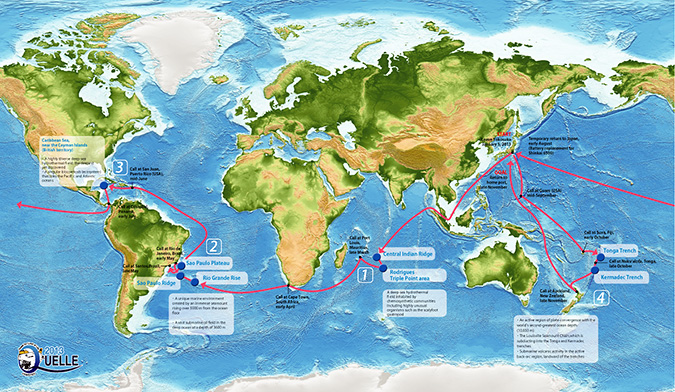 Completion of QUELLE2013
Completion of QUELLE2013
It took about a year for YOKOSUKA and SHINKAI 6500 to make their round-the-world voyage, named QUELLE2013 (an acronym for “Quest for the Limit of Life”), in 2013. They encountered extreme environments such as hydrothermal vent fields, submarine seepage sites, the ultra-hadal zone, and isolated ocean seamounts and plateaus, aiming to study the extreme habitats of the oceans near the limits of life, and reveal the unyielding survival strategies of life on earth. QUELLE2013 sought to exhibit JAMSTEC as a Center of Excellence for international deep-sea research and survey technology, and Japan as a leader in marine research.

[Track chart]

Scaly-foot gastropod collected from the hydrothermal vents of the Central Indian Ridge
YOKOSUKA and SHINKAI 6500 departed from the headquarters of JAMSTEC in Yokosuka, Japan on January 5, 2013 to begin their voyage around the world. After they carried out their underwater surveys around the world, primarily in the southern hemisphere, both SHINKAI 6500 and its support vessel YOKOSUKA safely returned to Japan on November 30, 2013.
In the Central Indian Ridge, despite adverse weather conditions, they collected a number of live scaly-foot gastropods. They were maintained on the ship and a variety of biological information was gathered in an attempt to answer questions such as: Why are these snails clad in iron sulfide armors? What is the mechanism of its biological formation? Numerous discoveries were made in the South Atlantic Ocean near the Brazilian seacoast, as this was the world’s first manned research submersible to enter these waters. More than anything, this survey revealed the South Atlantic Ocean as a treasure trove of biodiversity with a variety of creatures. The voyage also made news with its discoveries tied to unlocking the mystery of the Rio Grande Rise, an immense seamount.

Organisms found at the bottom of the Rio Grande Rise off Brazil

Granite discovered in the Rio Grande Rise off Brazil

Manganese nodules covering the south Sao Paulo Plateau off Brazil
At the Cayman Rise in the Caribbean Sea near the Cayman Islands, fiber optics were used to achieve the world’s first live transmission underwater, broadcast on the Internet. Scientific results included the gathering of numerous organisms that live in the world’s deepest hydrothermal environments, as well as collecting geochemical data. Then, in the Tonga Trench, we explored the world’s second-greatest ocean depth (10,850 m in depth), the Horizon Deep, where we produced a detailed terrestrial map, inserted a deep-sea Lander system to take footage and samples of the seabed, and succeeded in taking clear video images and surveying the oxygen profile of the site—a world’s first. Another surprise was the discovery of a supergiant amphipod measuring over 9 inches (24 cm), which was sampled at a 6,250 m depth on the edge of the trench. In the Kermadec Trench, data were gathered to examine the ecological transition of seamounts subducting into the trench, and hydrothermal activity along with a hydrothermal community was discovered in the northernmost end of the Kermadec arc.

Rimicaris hybisae clustered around a chimney in the Caribbean Beebe hydrothermal vent field, broadcast in real time from the manned research submersible

The first supergiant amphipod (Alicella gigantea) collected from the Tonga Trench in the South Pacific Ocean, measuring 24 cm in length.

A hydrothermal vent field discovered at 369 m depth, at Hinepuia Seamount in the northern Kermadec Arc in the South Pacific
The QUELLE2013 voyage is completed. So what was the voyage’s contribution? More than anything else, the great accomplishment was researching the previously unexplored extreme deep-sea environments of the southern hemisphere, making various scientific discoveries and gathering valuable samples and data. We especially pride ourselves in the fact that many new discoveries were made as a result of humankind voyaging into the deep ocean and exploring it with our five senses. The voyage has also proved beneficial in exhibiting JAMSTEC as a Center of Excellence for international deep-sea research and survey techniques, and Japan as a leader in marine research. Furthermore, through these activities, we contributed to international research projects currently underway, INDEEP (the International Network for Scientific Investigations of Deep-Sea Ecosystems) and InterRidge (International Cooperation in Ridge-Crest Studies), and especially to laying the groundwork for leading marine research in the 21st century in close cooperation with New Zealand and Brazil, countries that are highly anticipated to be among the future leaders in southern hemisphere sea studies. We hear that in the leading deep-sea exploration community IODP (International Ocean Discovery Program), the U.S. and European teams have also begun looking into exploration of the South Atlantic Ocean. We feel that this was also, in part, inspired by our achievements. The details of our results are now being compiled, and we will subsequently announce them going forward. We hope to continue to unlock the mysteries of the deep sea. In consideration of these results, we are also starting plans for the next QUELLE voyage.
The deep sea is brimming with attractions, and this is a leading field in which various challenges hold much promise. We will continue to present our findings and hope you will continue to watch us in the future.
>> Quest for the Limit of Life – An around-the-world voyage by the SHINKAI 6500 – QUELLE2013
Hiroshi Kitazato
Research Director
Institute of Biogeosciences (BioGeos)
